第48号令职业病危害项目申报办法
职业病危害项目申报管理办法

职业病危害项目申报管理办法中华人民共和国卫生部令第21号《职业病危害项目申报管理办法》已于2002年3月15日经卫生部部务会讨论通过,现予发布,自2002年5月1日起施行。
中华人民共和国卫生部部长:张文康二OO二年三月十五日职业病危害项目申报管理办法第一条为了规范职业病危害项目申报工作,加强职业病危害项目的监督管理,根据《中华人民共和国职业病防治法》(以下简称《职业病防治法》),制定本办法。
第二条存在或者产生职业病危害项目的用人单位,应当按照《职业病防治法》及本办法规定申报职业病危害项目。
本办法所称职业病危害项目是指存在或者产生职业病危害因素的项目。
职业病危害因素按照卫生部发布的《职业病危害因素分类目录》确定。
第三条职业病危害项目申报的主要内容是:(一)用人单位的基本情况;(二)工作场所职业病危害因素种类、浓度或强度;(三)产生职业病危害因素的生产技术、工艺和材料;(四)职业病危害防护设施,应急救援设施。
第四条用人单位应当向所在地县级卫生行政部门申报职业病危害项目,申报时应当提交《职业病危害项目申报表》及有关材料。
卫生行政部门应当在收到申报材料后5个工作日之内,出具《职业病危害项目申报回执》。
新建、改建、扩建、技术改造、技术引进项目,应当在竣工验收之日起30日内申报职业病危害项目。
第五条用人单位申报后,因采用的生产技术、工艺、材料等变更导致所申报的职业病危害因素及其相关内容发生改变的,应当在变更后30日内向原申报机关申报变更内容。
第六条用人单位终止生产经营时,应当向原申报机关办理申报注销手续。
第七条受理申报的卫生行政部门应当建立职业病危害项目管理档案。
县级以上卫生行政部门应当按有关规定逐级汇总上报。
第八条卫生行政部门应当对用人单位申报的情况进行抽查,并对职业病危害项目实施监督管理。
第九条用人单位违反《职业病防治法》及本办法的规定,未申报职业病危害项目或者申报不实的,责令限期改正,给予警告,可以并处2万元以上5万元以下罚款。
职业病危害项目申报办法
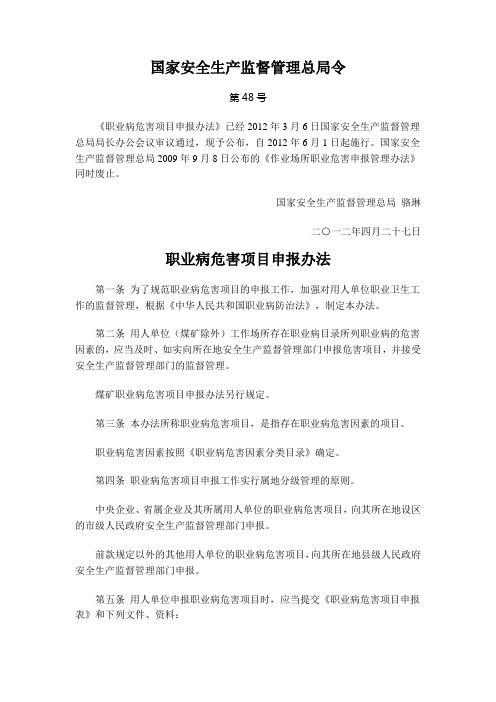
国家安全生产监督管理总局令第48号《职业病危害项目申报办法》已经2012年3月6日国家安全生产监督管理总局局长办公会议审议通过,现予公布,自2012年6月1日起施行。
国家安全生产监督管理总局2009年9月8日公布的《作业场所职业危害申报管理办法》同时废止。
国家安全生产监督管理总局骆琳二○一二年四月二十七日职业病危害项目申报办法第一条为了规范职业病危害项目的申报工作,加强对用人单位职业卫生工作的监督管理,根据《中华人民共和国职业病防治法》,制定本办法。
第二条用人单位(煤矿除外)工作场所存在职业病目录所列职业病的危害因素的,应当及时、如实向所在地安全生产监督管理部门申报危害项目,并接受安全生产监督管理部门的监督管理。
煤矿职业病危害项目申报办法另行规定。
第三条本办法所称职业病危害项目,是指存在职业病危害因素的项目。
职业病危害因素按照《职业病危害因素分类目录》确定。
第四条职业病危害项目申报工作实行属地分级管理的原则。
中央企业、省属企业及其所属用人单位的职业病危害项目,向其所在地设区的市级人民政府安全生产监督管理部门申报。
前款规定以外的其他用人单位的职业病危害项目,向其所在地县级人民政府安全生产监督管理部门申报。
第五条用人单位申报职业病危害项目时,应当提交《职业病危害项目申报表》和下列文件、资料:(一)用人单位的基本情况;(二)工作场所职业病危害因素种类、分布情况以及接触人数;(三)法律、法规和规章规定的其他文件、资料。
第六条职业病危害项目申报同时采取电子数据和纸质文本两种方式。
用人单位应当首先通过“职业病危害项目申报系统”进行电子数据申报,同时将《职业病危害项目申报表》加盖公章并由本单位主要负责人签字后,按照本办法第四条和第五条的规定,连同有关文件、资料一并上报所在地设区的市级、县级安全生产监督管理部门。
受理申报的安全生产监督管理部门应当自收到申报文件、资料之日起5个工作日内,出具《职业病危害项目申报回执》。
职业病危害项目申报制度
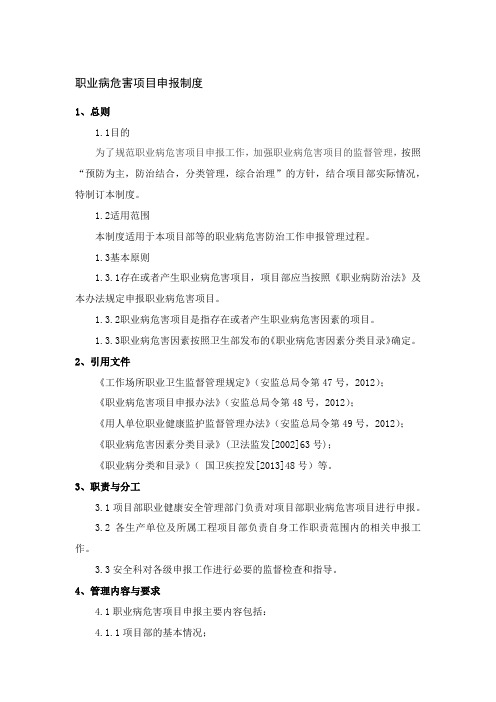
职业病危害项目申报制度
1、总则
1.1目的
为了规范职业病危害项目申报工作,加强职业病危害项目的监督管理,按照“预防为主,防治结合,分类管理,综合治理”的方针,结合项目部实际情况,特制订本制度。
1.2适用范围
本制度适用于本项目部等的职业病危害防治工作申报管理过程。
1.3基本原则
1.3.1存在或者产生职业病危害项目,项目部应当按照《职业病防治法》及本办法规定申报职业病危害项目。
1.3.2职业病危害项目是指存在或者产生职业病危害因素的项目。
1.3.3职业病危害因素按照卫生部发布的《职业病危害因素分类目录》确定。
2、引用文件
《工作场所职业卫生监督管理规定》(安监总局令第47号,2012);
《职业病危害项目申报办法》(安监总局令第48号,2012);
《用人单位职业健康监护监督管理办法》(安监总局令第49号,2012);
《职业病危害因素分类目录》(卫法监发[2002]63号);
《职业病分类和目录》(国卫疾控发[2013]48号)等。
3、职责与分工
3.1项目部职业健康安全管理部门负责对项目部职业病危害项目进行申报。
3.2各生产单位及所属工程项目部负责自身工作职责范围内的相关申报工作。
3.3安全科对各级申报工作进行必要的监督检查和指导。
4、管理内容与要求
4.1职业病危害项目申报主要内容包括:
4.1.1项目部的基本情况;。
职业病危害项目申报办法
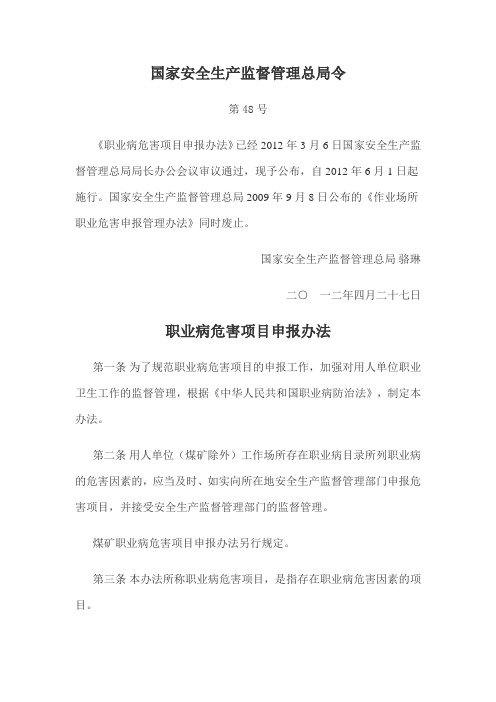
国家安全生产监督管理总局令第48号《职业病危害项目申报办法》已经2012年3月6日国家安全生产监督管理总局局长办公会议审议通过,现予公布,自2012年6月1日起施行。
国家安全生产监督管理总局2009年9月8日公布的《作业场所职业危害申报管理办法》同时废止。
国家安全生产监督管理总局骆琳二○一二年四月二十七日职业病危害项目申报办法第一条为了规范职业病危害项目的申报工作,加强对用人单位职业卫生工作的监督管理,根据《中华人民共和国职业病防治法》,制定本办法。
第二条用人单位(煤矿除外)工作场所存在职业病目录所列职业病的危害因素的,应当及时、如实向所在地安全生产监督管理部门申报危害项目,并接受安全生产监督管理部门的监督管理。
煤矿职业病危害项目申报办法另行规定。
第三条本办法所称职业病危害项目,是指存在职业病危害因素的项目。
职业病危害因素按照《职业病危害因素分类目录》确定。
第四条职业病危害项目申报工作实行属地分级管理的原则。
中央企业、省属企业及其所属用人单位的职业病危害项目,向其所在地设区的市级人民政府安全生产监督管理部门申报。
前款规定以外的其他用人单位的职业病危害项目,向其所在地县级人民政府安全生产监督管理部门申报。
第五条用人单位申报职业病危害项目时,应当提交《职业病危害项目申报表》和下列文件、资料:(一)用人单位的基本情况;(二)工作场所职业病危害因素种类、分布情况以及接触人数;(三)法律、法规和规章规定的其他文件、资料。
第六条职业病危害项目申报同时采取电子数据和纸质文本两种方式。
用人单位应当首先通过“职业病危害项目申报系统”进行电子数据申报,同时将《职业病危害项目申报表》加盖公章并由本单位主要负责人签字后,按照本办法第四条和第五条的规定,连同有关文件、资料一并上报所在地设区的市级、县级安全生产监督管理部门。
受理申报的安全生产监督管理部门应当自收到申报文件、资料之日起5个工作日内,出具《职业病危害项目申报回执》。
34.职业病危害项目申报办法

职业病危害项目申报办法国家安全生产监督管理总局令第48号《职业病危害项目申报办法》已经2012年3月6日国家安全生产监督管理总局局长办公会议审议通过,现予公布,自2012年6月1日起施行。
国家安全生产监督管理总局2009年9月8日公布的《作业场所职业危害申报管理办法》同时废止。
国家安全生产监督管理总局骆琳二○一二年四月二十七日第一条为了规范职业病危害项目的申报工作,加强对用人单位职业卫生工作的监督管理,根据《中华人民共和国职业病防治法》,制定本办法。
第二条用人单位(煤矿除外)工作场所存在职业病目录所列职业病的危害因素的,应当及时、如实向所在地安全生产监督管理部门申报危害项目,并接受安全生产监督管理部门的监督管理。
煤矿职业病危害项目申报办法另行规定。
第三条本办法所称职业病危害项目,是指存在职业病危害因素的项目。
职业病危害因素按照《职业病危害因素分类目录》确定。
第四条职业病危害项目申报工作实行属地分级管理的原则。
中央企业、省属企业及其所属用人单位的职业病危害项目,向其所在地设区的市级人民政府安全生产监督管理部门申报。
前款规定以外的其他用人单位的职业病危害项目,向其所在地县级人民政府安全生产监督管理部门申报。
第五条用人单位申报职业病危害项目时,应当提交《职业病危害项目申报表》和下列文件、资料:(一)用人单位的基本情况;(二)工作场所职业病危害因素种类、分布情况以及接触人数;(三)法律、法规和规章规定的其他文件、资料。
第六条职业病危害项目申报同时采取电子数据和纸质文本两种方式。
用人单位应当首先通过“职业病危害项目申报系统”进行电子数据申报,同时将《职业病危害项目申报表》加盖公章并由本单位主要负责人签字后,按照本办法第四条和第五条的规定,连同有关文件、资料一并上报所在地设区的市级、县级安全生产监督管理部门。
受理申报的安全生产监督管理部门应当自收到申报文件、资料之日起5个工作日内,出具《职业病危害项目申报回执》。
职业病危害项目申报办法-安监总局48号令-英文版本
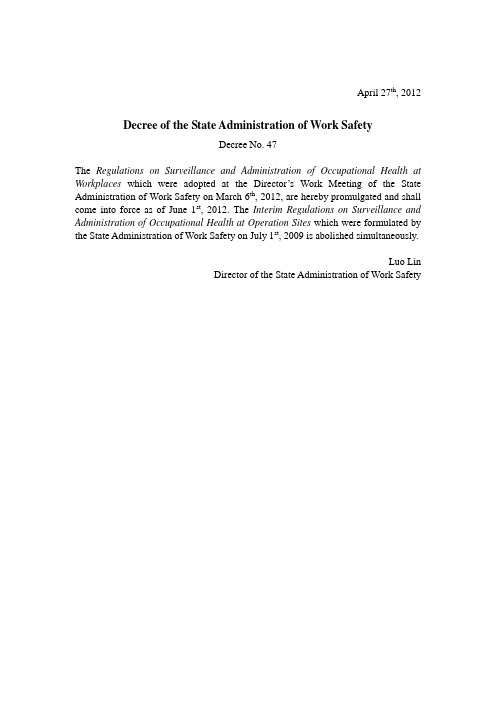
April 27th, 2012Decree of the State Administration of Work SafetyDecree No. 47The Regulations on Surveillance and Administration of Occupational Health at Workplaces which were adopted at the Director’s Work Meeting of the State Administration of Work Safety on March 6th, 2012, are hereby promulgated and shall come into force as of June 1st, 2012. The Interim Regulations on Surveillance and Administration of Occupational Health at Operation Sites which were formulated by the State Administration of Work Safety on July 1st, 2009 is abolished simultaneously.Luo LinDirector of the State Administration of Work SafetyRegulations on Surveillance and Administration of Occupational Health atW orkplacesChapter I General ProvisionsArticle 1Pursuant to the Law of the Peopl e’s Republic of China on Prevention and Control of Occupational Diseases, other laws, regulations and administrative rules, these Regulations are formulated to reinforce the surveillance and administration of occupational health, to stress on the responsibilities of the Employer as the subject for the prevention and control of occupational diseases, to prevent and control occupational hazards, and to secure health, relevant rights and interests of the workers.Article 2 These Regulations shall be applicable to the Employer’s prevention and control of occupational diseases, and the surveillance and administration performed by the surveillance and administration departments of work safety over the implementation of prevention and control activities of the Employer.Article 3 The Employer shall strengthen the prevention and control of occupational diseases, so as to provide its workers with the working environment and working conditions that comply with relevant laws, regulations, rules, standards and requirements on occupational health of the State; and effective measures shall be taken as well to ensure the occupational health of the workers.Article 4 The Employer shall be the subject of liability concerning the prevention and control of occupational diseases, and shall assume responsibilities for the occupational hazards generated.The principal of the Employer shall take full responsibility for the prevention and control of occupational diseases of his/her Employer.Article 5 The State Administration of Work Safety shall, in accordance with the Law of the Peopl e’s Republic of China on Prevention and Control of Occupational Diseases, and duties assigned by the State Council, be responsible for the surveillance and administration of occupational health of the Employers nationwide.The surveillance and administration departments of work safety under local people’s governments above county level shall, in accordance with the Law of the Peopl e’s Republic of China on Prevention and Control of Occupational Diseases, and duties assigned by the people’s governments at the same level, be responsible for the surveillance and administration of occupational health of the Employers in their own administrative regions.Article 6 The occupational health technical service institutions that are intended toprovide technical services for the prevention and control of occupational diseases shall, in accordance with the Interim Measures for the Surveillance and Administration of Occupational Health Technical Service Institutions as well as the requirements in relevant standards, codes and codes of practice, provide technologies and services to the Employers.Article 7 Any unit or individual shall have the right to accuse the offending activities of these Regulations and occupational hazard accidents that happen in the Employers to the surveillance and administration departments of work safety.Chapter II Responsibilities of the EmployerArticle 8 The Employer having serious occupational hazards shall establish or assign occupational health management agencies or organizations, and dispatch full-time occupational health officers.Other Employers having occupational hazards shall, with more than 100 workers, establish or assign occupational health management agencies or organizations, and dispatch full-time occupational health officers; as for the Employers with less than 100 workers, they shall dispatch full-time or part-time occupational health officers to be responsible for the prevention and control of occupational diseases.Article 9 The principals and occupational health officers of the Employer shall have adequate occupational health knowledge and management capability of the production and operation activities of the Employer; and participate in occupational health trainings.The occupational health trainings given to the principals and occupational health officers of the Employer shall mainly include the following contents:(I) Relevant laws, regulations, rules and standards on occupational health of the State; (II) Basic knowledge on the prevention and control of occupational hazards;(III) Relevant knowledge on the administration of occupational health;(IV) Other contents as specified by the State Administration of Work Safety.Article 10 The Employer shall organize pre-job occupational health trainings and periodical on-job occupational health trainings for its workers to popularize occupational health knowledge, and urge the workers to abide by the laws, regulations, and rules on the prevention and control of occupational diseases, as well as standards and operating procedures on occupational health of the State.The Employer shall organize special trainings on occupational health for the workers taking the posts with serious occupational hazards; only the qualified workers who have participated in the trainings can go on duty to operate.In case change of occupational hazardous factors that are exposed to the workers happens due to the change of processes, technologies, equipment and materials, or adjustment of positions, the Employer shall re-organize pre-job occupational health trainings for its workers.Article 11 The Employer having occupational hazards shall prepare occupational hazard prevention & control plans and implementation schemes; meanwhile, establish and perfect the following management systems and operating procedures on occupational health:(I) Liability system for the prevention and control of occupational hazards;(II) Warning and informing system of occupational hazards;(III) Reporting system of projects with occupational hazards;(IV) Publicity, education and training system on the prevention and control of occupational hazards;(V) Maintenance system of the prevention and control facilities against occupational diseases;(VI) Management system of the protective articles against occupational diseases; (VII) Management system for the monitoring and assessment of occupational hazards; (VIII) The “Three-simultaneous”management system for occupational health in construction projects;(IX) Occupational health surveillance of the workers and management system of archives;(X) Treatment and reporting system of occupational hazard accidents;(XI) Emergency response, rescue and management system of occupational hazards; (XII) Position occupational health operating procedures;(XIII) Other systems on the prevention and control of occupational diseases as set forth in laws, regulations and rules.Article 12 The workplaces of the Employer producing occupational hazards shall comply with the following basic requirements:(I) Production layout shall be rational, separating hazardous operations from non-hazardous operations;(II) Workplaces shall be separated from the living quarters; and the workers are not allowed to live in the workplaces;(III) Effective protective facilities compatible to the prevention and control work against occupational diseases shall be established;(IV) The intensity or concentration of occupational hazardous factors shall reach the standards on occupational health of the States;(V) Supporting locker rooms, bath rooms, lounges for pregnant women, and other health facilities shall be provided;(VI) Equipment, tools, apparatus, and other facilities shall comply with the requirements on the protection of physical and mental health of the workers;(VII) Other provisions as specified in relevant laws, regulations, rules and standards on occupational health of the State.Article 13 In case there are occupational hazardous factors which are included in the List of Occupational Diseases in the workplaces of the Employer, the Employer shall, in accordance with the provisions as specified in the Measures for the Report of Projects with Occupational Hazards, report the projects with occupational hazards in a timely and truthful manner; and accept the surveillance and inspection of local surveillance and administration department of work safety.Article 14 As for new construction projects, renovated projects, expanded projects, technical transformation projects and technical introduction projects (hereinafter referred to as “construction projects”) which may generate occupational hazards, the Project Owners shall, in accordance with the provisions as specified in the Interim Measures on “Three Simultaneous” Surveillance and Administration of Occupational Health in Construction Projects, apply for filing, verification, inspection and completion acceptance with the surveillance and administration departments of work safety.Article 15 The Employer that may generate occupational hazards shall set up bulletin boards in eye-catching places, publishing the rules, regulations and operating procedures on the prevention and control of occupational diseases, emergency response and rescue measures for occupational hazard accidents, as well as the testing results of occupational hazardous factors in workplaces.According to the provisions as specified in the Warning Signs for OccupationalHazards in Workplaces (GBZ158), warning signs and Chinese warning specifications including graphics, warning lines and warning slogans shall be set up in eye-catching places in workplaces, operation positions, equipment and facilities that have or generate occupational hazards.According to the provisions as specified in the Warning Specification for Occupational Hazards of Highly Toxic Substances in the Workplaces (GBZ/T203), warning cards shall be set up in eye-catching places for operation positions that have or generate highly toxic substances, specifying the name, physical & chemical characters, health hazards, protective measures, emergency response treatment, other warning contents and warning signs.Article 16 The Employer shall provide its workers with protective articles against occupational diseases which can reach the occupational health standards of the State; urge and guide its workers to appropriately wear and apply the protective articles according to the rules of use; the Employer shall not distribute money to replace the protective articles against occupational diseases.The Employer shall conduct maintenance of the protective articles against occupational diseases in a frequent manner to ensure the effectiveness of the protective articles; the protective articles against occupational diseases which cannot reach the occupational health standards of the State or become invalid shall not be used.Article 17 The Employer shall, for toxic and hazardous workplaces which may generate acute occupational injuries, set up alarming devices, provide on-site first-aid articles and washing equipment, and establish emergency evacuation routes and necessary hazard-eliminating areas.On-site first-aid articles and washing equipment shall be placed in the workplaces which may generate acute occupational injuries, or nearby locations with clear signs in eye-catching places.Apart from the provisions in paragraph I and II of this Article, the Employer shall, in enclosed or semi-enclosed workplaces that may abruptly leak or discharge hazardous substances in a large amount, install accident ventilation units and leakage alarming units which are connected with accident ventilation system.As for places for the production, sales, application and storage of radioisotopes and radioactive units, the Employer shall set up eye-catching signs for radiation according to relevant provisions of the State; the entrances of these places shall, in accordance with the requirements in relevant safety and protective standards of the States, be equipped with safety and protective facilities, necessary safety protective interlock and alarming units or operating signals. The production, commissioning andapplication places of radioactive units shall be provided with safety measures against mis-operation and unexpected exposure to radiation. The Employer shall provide proper protective articles and monitoring instrument compatible to the type and intensity of radiation, including personal dosage measurement and alarming equipment, fixed and portable radiation monitoring equipment, surface pollution monitoring equipment and effluent monitoring equipment; meanwhile, as well as ensure that the workers who may be exposed to radioactive rays shall wear personal dosimeters.Article 18 The Employer shall perform frequent maintenance and repair of the protective equipment, emergency response and rescue facilities against occupational diseases; test the performance and effects of these equipment and facilities periodically, so as to ensure their normal operation. It is forbidden to remove or put these equipment and facilities out of service without the approval from competent authorities.Article 19 The Employer having occupational hazards shall perform daily monitoring of occupational hazardous factors in workplaces by designated person, so as to ensure normal operation of the monitoring system.Article 20 The Employer having occupational hazards shall assign occupational health technical service institutions with corresponding qualification to carry out testing of occupational hazardous factors at least once a year.The Employer having serious occupational hazards shall, apart from the provisions in the preceding paragraph, assign occupational health technical service institutions with corresponding qualification to carry out assessment of occupational hazard status at least once every three years.The testing and assessment results shall be put into the occupational heath archives of the Employer; reported to the surveillance and administration departments of work safety, and disclosed to the workers.Article 21 The Employer having occupational hazards shall, under one of the following circumstances, assign occupational health technical service institutions with corresponding qualification to carry out assessment of occupational hazard status in a timely manner:(I) Apply for the occupational health safety permit for the first time, or apply for the renewal upon expiration of the permit;(II) Occupational hazard accident happens to the Employer;(III) Other situations as specified by the State Administration of Work Safety.The Employer shall put in place the recommendations and measures that are raised in the report on the assessment of occupational hazard status; and incorporate status assessment results and correction situations of occupational hazards into the occupational health archives.Article 22 In case the Employer identify, during daily monitorings, or periodical inspections and status assessments of occupational hazards, that the occupational hazardous factors in workplaces fail to meet the occupational health standards and requirements of the State, they shall immediately take corresponding correction measures to ensure that the occupational hazardous factors in workplaces can meet the occupational health standards and requirements of the State; if it fails again after correction, the operations with occupational hazardous factors must be suspended, and can only be resumed when the occupational hazardous factors can meet the occupational health standards and requirements of the State after correction.Article 23 Any supplier that provides equipment which may generate occupational hazards to the Employer shall provide Chinese specifications, and sets up warning signs and Chinese warning specifications in eye-catching places in the equipment. The contents of warming specifications shall cover the performance of equipment, potential occupational hazards, cautions for safe operation and maintenance, protective measures against occupational diseases, etc.The Employer shall check the equipment according to the provisions in the preceding paragraph, and shall not use any equipment which cannot meet relevant requirements.Article 24 Any s upplier that provides chemicals, radioisotopes and materials with radioactive substances which may generate occupational hazards to the Employer shall provide Chinese specifications. The contents of specifications shall cover the features of products, main components, existing hazardous factors, potential hazardous results, cautions for safe application, protective measures, emergency response and rescue measures against occupational diseases, and other contents. Clear warning signs and Chinese warning specifications shall be placed in the packaging of products. Signs of hazardous articles or warning signs of radioactive articles shall be placed in specific locations in the storage places of the abovementioned materials.The Employer shall check the materials according to the provisions in the preceding paragraph, and shall not use any material which cannot meet relevant requirements. Article 25 No Employer shall be allowed to use the equipment or materials expressly prohibited by the State that may generate occupational hazards.Article 26 No Employer or individual shall be allowed to transfer the operations that may generate occupational hazards to other Employers or individuals that do not have the protective conditions against occupational diseases. The unqualified Employers orindividuals shall not accept those operations that may generate occupational hazards.Article 27 The Employer shall adopt new technologies, processes, materials and equipment which are helpful for the prevention and control of occupational hazards as well as the protection of the health of workers, to gradually replace those technologies, processes, materials and equipment which can generate occupational hazards.Article 28 The Employer shall be familiar with the potential occupational hazards that are produced by the technologies, processes, materials and equipment adopted, and shall take corresponding protective measures. In case the Employer adopts those technologies, processes, materials and equipment posing occupational hazards and intentionally prevent such occupational hazards from the awareness of relevant parties, the Employer shall take corresponding liabilities for the consequences caused by those occupational hazards.Article 29 The Employer shall, while executing labor contracts (including employment contracts, the same below) with its workers, truthfully notify the occupational hazards that may be produced from work procedures and their consequences, protective measures against occupational diseases, remuneration and other relevant issues; all of which shall be specified in the labor contracts; concealment or deception on the abovementioned issues is not allowed.In case the job positions or job contents of the workers are changed during the term of the labor contract, and the workers are required to perform other operations with occupational hazards which are not specified in the contract executed, the Employer shall, in accordance with the provisions in the preceding paragraph, notify of the workers of such hazards, and change relevant terms and conditions in the original labor contract through negotiation.In case the Employer violates the provisions in this Article, the workers shall have right to refuse to perform the operations with occupational hazards; and the Employer shall not terminate the labor contract executed with the workers therefrom.Article 30 The Employer shall, in accordance with the provisions as set forth in the Measures for the Supervision and Administration of Employers’ Occupational Health Surveillance, Administrative Measures for the Occupational Health of Radiation Workers, Guideline of Occupational Health Surveillance (GBZ188), Technical Specifications for Occupational Health Surveillance for Radiation Workers (GBZ235), et., organize pre-the-job trainings, on-the-job trainings, off-the-job occupational health examination for the workers who perform the operations having occupational hazardous factors; and truthfully notify the examination results in written form to the workers.The charge for such occupational health examinations shall be covered by theEmployer.Article 31 The Employer shall, in accordance with the provisions as set forth in the Measures for the Supervision and Administration of Employers’ Occupational Health Surveillance, create occupational health surveillance archives for its workers and keep these archives for a given time period.The contents of the occupational health surveillance archive shall include occupational history of workers, exposure of occupational hazards, results of occupational health examination, treatment results, diagnosis and treatment of occupational diseases, and other materials on personal health.The workers shall, when quitting the job offered by the Employer, shall have the right to ask for the copy of his/her occupational health surveillance archive; the Employer shall provide true and chopped copy of the archive for free.Article 32 The Employer shall, when the health of the worker is damaged and requires diagnosis and confirmation, provide true occupational history, exposure history of occupational hazards, testing results of occupational hazardous factors in the workplaces, monitoring results of personal dosage of radiation worker, as well as other materials that are required by the diagnosis and confirmation of occupational diseases.Article 33 The Employer shall not assign juvenile workers to undertake operations exposed to occupational hazards, or assign workers having occupational contraindications to undertake operations that they shall avoid; or assign women workers in pregnancy or lactation to undertake hazardous operations to herself, her fetus and baby.Article 34 The Employer shall establish and perfect the following occupational health archives and data:(I) Document regarding the responsibility system on the prevention and control of occupational diseases;(II) Regulations, rules and operating procedures on the administration of occupational health;(III) List of the types of occupational hazardous factors in workplaces, position distribution, exposure of workers, etc;(IV) Basic information on protective facilities, emergency response and rescue facilities against occupational diseases, and the records on configuration, application, maintenance, repair and replacement of these facilities;(V) Testing and assessment reports and records on occupational hazards in workplaces;(VI) Records on the provision, distribution, maintenance and replacement of protective facilities against occupational diseases;(VII) Training materials on occupational health for the principals, occupational health officers, workers taking the posts with serious occupational hazards, and other relevant staff;(VIII) Reports on occupational hazard accidents and records on emergency response and treatment;(IX) Summary of the physical examination results of workers, and records on the treatment and arrangement of workers having occupational contraindications, occupational health damages or occupational diseases;(X) Relevant technical data on “Three simultaneous” system for occupational health in construction projects, and relevant replies or approval documents regarding filing, checking, inspection or acceptance test, etc.;(XI) Relevant replies or approval documents regarding the application and receiving of the occupational health safety permit, and the report of projects with occupational hazards;(XII) Other materials or documents related to occupational health administration.Article 35 The Employer shall, in a timely fashion, report the occupational hazard accidents to local surveillance and administration department of work safety, and take effective measures to alleviate or eliminate occupational hazardous factors, so as to prevent the accident from getting more serious. The Employer shall provide timely medical treatment, physical examination and medical observation for the workers who are suffering from or possibly suffer from acute occupational hazards; all the expenses therefrom shall be covered by the Employer.The Employer shall not intentionally destroy the accident scene and relevant evidences; nor delay the report, fail to report, provide false reports, or hide truth in making the report on occupational hazard accidents.Article 36 The Employer shall, when identifying patients suffering from occupational diseases or suspected occupational diseases, report such case to local surveillance and administration department of work safety and relevant departments in a timely fashion in accordance with relevant provisions of the State.Article 37 In case toxic articles are applied in the workplaces of the Employer, the Employer shall apply and handle occupational health safety permit with the surveillance and administration department of work safety in accordance with relevant provisions.Article 38 The Employer shall cooperate with the law enforcement officials from the surveillance and administration departments of work safety when they are performing their surveillance and inspection duties; shall not refuse or obstruct them from executing their duties.Chapter III Surveillance and AdministrationArticle 39 The surveillance and administration department of work safety shall conduct surveillance and inspection over the execution of laws, regulations and rules on the prevention and control of occupational diseases, as well as standards on occupational health of the State by the Employer according to laws; the following contents shall be emphasized during surveillance and inspection:(I) Establishment or assignment of occupational health administration agencies or organizations; and allocation of full-time or part-time occupational health officer;(II) Establishment, implementation and publishing of the occupational health administration systems and operating procedures;(III) Occupational health trainings for the principals, occupational health officers, workers taking the posts with serious occupational hazards(IV) Implementation of the “Three simultaneous”system on occupational health in construction projects;(V) Report of the projects with occupational hazards in the workplaces;(VI) Report on the monitoring, testing and assessment results of occupational hazardous factors in workplaces and disclosure of the results;(VII) Provision and maintenance of protective facilities, emergency response and rescue facilities against occupational diseases; distribution and management of protective articles against occupational diseases, as well as the wearing and application of these articles by the workers;(VIII) Warning and notification of the occupational hazardous factors and their consequences;(IX) Supervision of workers’ occupational health, and monitoring of personal dosageof radiation workers;(X) Report of occupational hazard accidents;(XI) Provision of materials on relationship between workers’occupational health damage and occupational history and exposure to occupational hazards, and other relevant materials;(XII) Other issues that are subject to surveillance and inspection according to laws.Article 40 The surveillance and administration department of work safety shall establish and perfect occupational health surveillance and inspection system, reinforce trainings on occupational health knowledge for law enforcement officials, and enhance professional competence of the administrative law enforcement officials.Article 41 The surveillance and administration department of work safety shall reinforce surveillance and administration of the “Three-simultaneous”system on occupational health in construction projects; establish and perfect the archive administration system for relevant materials.Article 42 The surveillance and administration department of work safety shall strengthen administration over qualification rectification of the occupational health technical service institutions, as well as surveillance and inspection of technologies and services provided; and urge the occupational health technical service institutions to provide fair, impartial, objective and scientific occupational health technologies and services.Article 43 The surveillance and administration department of work safety shall establish and perfect the information statistics and analysis system on the prevention and control of occupational hazards; and reinforce statistics, summary and analysis of testing and assessment results of occupational hazardous factors of the Employer, information on workers’occupational health surveillance, information on occupational health surveillance and inspection, etc.Article 44 The surveillance and administration department of work safety shall, in accordance with relevant provisions, cooperate with and support relevant departments ad organizations to perform diagnosis and confirmation of occupational diseases. Article 45 The law enforcement officials from the surveillance and administration department of work safety shall produce their effective law enforcement certificates before performing their surveillance and inspection duties according to laws.The law enforcement officials shall be devoted to their duties, enforce laws impartially, and strictly follow the rules on law enforcement; they shall also keep the。
《职业病危害项目申报办法》国家安全生产监督管理总局令第48号

《职业病危害项目申报办法》国家安全生产监督管理总局令【2012】第48号《职业病危害项目申报办法》已经2012年3月6日国家安全生产监督管理总局局长办公会议审议通过,现予公布,自2012年6月1日起施行。
国家安全生产监督管理总局2009年9月8日公布的《作业场所职业危害申报管理办法》同时废止。
第一条为了规范职业病危害项目的申报工作,加强对用人单位职业卫生工作的监督管理,根据《中华人民共和国职业病防治法》,制定本办法。
第二条用人单位(煤矿除外)工作场所存在职业病目录所列职业病的危害因素的,应当及时、如实向所在地安全生产监督管理部门申报危害项目,并接受安全生产监督管理部门的监督管理。
煤矿职业病危害项目申报办法另行规定。
第三条本办法所称职业病危害项目,是指存在职业病危害因素的项目。
职业病危害因素按照《职业病危害因素分类目录》确定。
第四条职业病危害项目申报工作实行属地分级管理的原则。
中央企业、省属企业及其所属用人单位的职业病危害项目,向其所在地设区的市级人民政府安全生产监督管理部门申报。
前款规定以外的其他用人单位的职业病危害项目,向其所在地县级人民政府安全生产监督管理部门申报。
第五条用人单位申报职业病危害项目时,应当提交《职业病危害项目申报表》和下列文件、资料:(一)用人单位的基本情况;(二)工作场所职业病危害因素种类、分布情况以及接触人数;(三)法律、法规和规章规定的其他文件、资料。
第六条职业病危害项目申报同时采取电子数据和纸质文本两种方式。
用人单位应当首先通过“职业病危害项目申报系统”进行电子数据申报,同时将《职业病危害项目申报表》加盖公章并由本单位主要负责人签字后,按照本办法第四条和第五条的规定,连同有关文件、资料一并上报所在地设区的市级、县级安全生产监督管理部门。
受理申报的安全生产监督管理部门应当自收到申报文件、资料之日起5个工作日内,出具《职业病危害项目申报回执》。
第七条职业病危害项目申报不得收取任何费用。
第48号令职业病危害项目申报办法
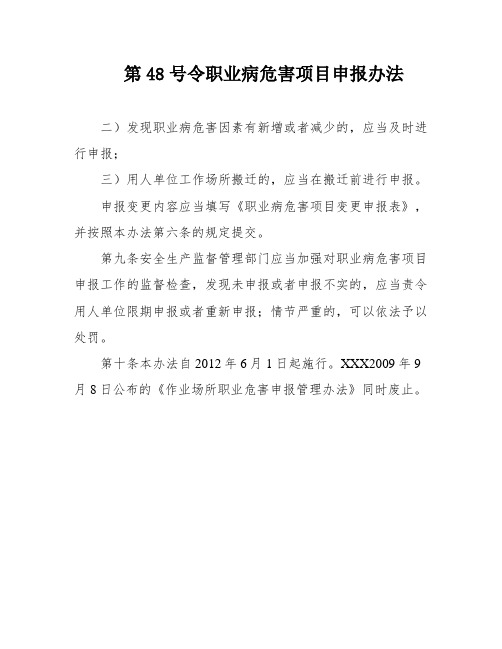
第48号令职业病危害项目申报办法
二)发现职业病危害因素有新增或者减少的,应当及时进行申报;
三)用人单位工作场所搬迁的,应当在搬迁前进行申报。
申报变更内容应当填写《职业病危害项目变更申报表》,并按照本办法第六条的规定提交。
第九条安全生产监督管理部门应当加强对职业病危害项目申报工作的监督检查,发现未申报或者申报不实的,应当责令用人单位限期申报或者重新申报;情节严重的,可以依法予以处罚。
第十条本办法自2012年6月1日起施行。
XXX2009年9月8日公布的《作业场所职业危害申报管理办法》同时废止。
职业病危害项目申报制度

职业病危害项目申报制度一、背景与目的近年来,职业病危害日益凸显,为了保障员工的身体健康和工作安全,提高企业的职业病预防能力和管理水平,制定本《职业病危害项目申报制度》。
本制度的目的是规范职业病危害项目的申报流程,确保在项目实施前,进行必要的危害评估和防护措施的制定,保证员工的安全和健康。
二、适用范围本制度适用于企业内部所有涉及职业病危害项目的申报和管理。
三、管理标准1. 职业病危害项目的申报流程(1)项目识别阶段•职业病防护责任人负责对潜在职业病危害项目进行识别。
•制定清单,明确可能存在职业病危害的部门、工种、工序和岗位。
•部门负责人对所属部门的职业病危害情况进行汇总。
(2)项目评估阶段•职业病防护责任人组织相关部门及专业技术人员,对职业病危害项目进行评估。
•评估过程中,需调查现场,进行取样检测,并编制评价报告。
(3)防护措施制定阶段•根据评估报告,职业病防护责任人制定职业病危害项目的防护措施建议和防护方案。
•防护措施建议和防护方案报经企业法务部门审查并确认。
(4)项目申报阶段•职业病防护责任人将职业病危害项目的评估报告、防护措施建议和防护方案报经企业法务部门审批。
•企业法务部门审批通过后,提供给相关管理部门备案。
2. 职业病危害项目的管理(1)相关部门的职责•人力资源部门需将职业病危害项目纳入招聘、培训、转岗、离岗的管理流程,确保员工了解职业病危害情况和相应防护措施。
•安全环保部门需对职业病危害项目的防护措施进行监督和检查,及时发现并解决相关问题。
•生产管理部门需积极配合职业病危害项目的防护措施的实施,确保员工的安全和健康。
(2)职业病危害项目的监测与评估•职业病防护责任人需定期组织职业病危害项目的监测与评估。
•检测内容包括工作场所环境、员工健康状况等。
•基于监测结果,及时调整防护措施。
(3)职业病危害项目的培训管理•企业需要组织相关人员进行职业病预防培训,确保员工了解职业病危害项目及防护措施。
受理职业病危害项目申报须知及办事流程

博爱县安监局受理职业病危害项目申报须知及办事流程
1 服务项目职业病危害项目申报
2 依据《职业病危害项目申报管理办法》(国家安全监管总局令第48号)
3 办事流程
职业病危害项目申报同时采取电子数据和纸质文本两种方式。
通过“职业病危害项目申报系统”进行电子数据申报→打印《职业病危害项目申报表》,加盖公章并由本单位主要负责人签字后,连同所需提交有关文件、资料一并上报所在地县级安全生产监督管理部门→受理申报的安全生产监督管理部门应当自收到申报文件、资料之日起5个工作日内,出具《职业病危害项目申报回执》。
4 申请单位
所需提交
材料
用人单位申报职业病危害项目时,应当提交《职业病危害项目申报表》和下列文件、资料:
(一)用人单位的基本情况;
(二)工作场所职业病危害因素种类、分布情况以及接触人数;
(三)法律、法规和规章规定的其他文件、资料。
5 申报变更
及注销
用人单位有下列情形之一的,应当按照本条规定向原申报机关申报变更职业病危害项目内容:
(一)进行新建、改建、扩建、技术改造或者技术引进建设项目的,自建设项目竣工验收之日起30日内进行申报;
(二)因技术、工艺、设备或者材料等发生变化导致原申报的职业病危害因素及其相关内容发生重大变化的,自发生变化之日起15日内进行申报;
(三)用人单位工作场所、名称、法定代表人或者主要负责人发生变化的,自发生变化之日起15日内进行申报;
(四)经过职业病危害因素检测、评价,发现原申报内容发生变化的,自收到有关检测、评价结果之日起15日内进行申报。
用人单位终止生产经营活动的,应当自生产经营活动终止之日起15日内向原申报机关报告并办理注销手续。
职业病危害项目申报制度

1、编制要点明确职业病危害项目申报制度的目的、依据。
确定职业病危害项目申报工作的负责部门、责任人。
详细编写职业病危害项目申报的具体内容:(职业病危害的场所、人员、使用原材料、工艺流程、可能产生或存在的职业病危害因素等)。
明确申报的部门、时段、时间及备档有关要求。
2、范例【样例1】职业病危害项目申报制度为保障员工的职业卫生和安全,防治职业病危害,根据《中华人民共和国职业病防治法》、以及《工作场所职业卫生管理规定》、《职业病危害项目申报办法》的规定,制订本制度:一、职业病危害项目申报工作主要由职业卫生管理机构负责,相关职能部门密切配合。
二、用人单位每年向卫生行政部门进行申报,申报分为网上和书面两种,申报时认真填写《职业病危害项目申报表》并加盖公章,由单位主要负责人签字后报相应卫生行政部门备案,备案结束后从卫生行政部门取回《职业病危害项目申报回执》。
三、申报内容主要包括以下几方面:1、用人单位的基本情况;2、产生职业病危害因素的生产技术、工艺和材料的情况;3、工作场所职业病危害因素的种类、浓度和强度的情况;4、工作场所接触职业病危害因素的人数及分布情况;5、职业病危害防护设施及个人防护用品的配备情况;6、对接触职业病危害因素从业人员的管理情况;7、法律、法规和规章规定的其他资料。
四、下列事项发生重大变化的,应在规定时间内向原申报机关申报变更:1、进行新建、改建、扩建、技术改造或者技术引进建设项目的,自建设项目竣工验收之日起30日内进行申报;2、因技术、工艺、设备或者材料等发生变化导致原申报的职业病危害因素及其相关内容发生重大变化的,自发生变化之日起15日内进行申报;3、用人单位工作场所、名称、法定代表人或者主要负责人发生变化的,在发生变化之日起15日内进行申报;4、经过职业病危害因素检测、评价,发现原申报内容发生变化的,自收到有关检测、评价结果之日起15日内进行申报;5、用人单位终止生产经营活动的,应当自生产经营活动终止之日起15日内向原申报机关报告并办理注销手续。
48号令 职业病危害项目申报办法

《职业病危害项目申报办法》(48号文)判断题1、中央企业、省属企业及其所属用人单位的职业病危害项目,向其所在地设区的省级人民政府安全生产监督管理部门申报。
A、正确B、错误2、职业病危害项目申报可只申报电子数据。
A、正确B、错误3、职业病危害项目申报不得收取任何费用。
A、正确B、错误4、因技术、工艺、设备或者材料等发生变化导致原申报的职业病危害因素及其相关内容发生重大变化的,自发生变化之日起15日内向原申报机关进行申报。
A、正确B、错误5、用人单位未按照本办法规定及时、如实地申报职业病危害项目的,责令限期改正,给予警告,可以并处5万元以上10万元以下的罚款。
A、正确B、错误单项选择题1、《职业病危害项目申报办法》是按照哪一部法律制定的()A.《安全生产法》B.《职业病防治法》C. 《工作场所职业卫生监督管理规定》D.《使用有毒物品作业场所劳动保护条例》2、进行新建、改建、扩建、技术改造或者技术引进建设项目的,自建设项目竣工验收之日起()日内进行申报;A 15 B. 30 C. 90 D. 六个月3、因技术、工艺、设备或者材料等发生变化导致原申报的职业病危害因素及其相关内容发生重大变化的,自发生变化之日起()日内进行申报。
A 15 B. 30 C. 90 D. 六个月4、用人单位工作场所、名称、法定代表人或者主要负责人发生变化的,自发生变化之日起()日内进行申报。
A 15 B. 30 C. 90 D. 六个月5、经过职业病危害因素检测、评价,发现原申报内容发生变化的,自收到有关检测、评价结果之日起()日内进行申报。
A 15 B. 3 0 C. 90 D. 六个月。
职业病危害项目申报制度(3篇)

职业病危害项目申报制度第一章总则第一条为了加强对职业病危害项目的管理,保障职工的健康与安全,提升工作环境的整体质量,根据相关法律法规的要求,制定本制度。
第二条本制度适用于所有从事具有职业病危害的项目的单位和个人。
第三条职业病危害项目指可能对从业人员的生命、身体和健康造成损害的工作项目,包括但不限于粉尘、化学物质、放射性物质、噪声、震动、高温、辐射等。
第四条本制度的目标是规范职业病危害项目的申报和管理,保障职工的健康与安全,减少职业病的发生,提升工作环境的整体质量。
第五条所有职业病危害项目的单位和个人都应按照本制度的规定进行申报、审批和管理。
第二章职业病危害项目的申报程序第六条职业病危害项目的申报程序包括申报、审批、备案和监督四个阶段。
第七条申报阶段:1.职业病危害项目的单位和个人应当按照规定的格式和要求填写申报表,并附上相关的材料和证明文件。
2.申报表应当包括项目的名称、性质、单位与个人的基本情况、项目的危害程度等内容。
3.申报表应当由单位或个人的主管部门签字并加盖公章。
第八条审批阶段:1.申报材料应当提交到职业病危害管理部门进行审批。
2.职业病危害管理部门应当对申报材料进行严格审核,确保申报的项目符合相关法律法规的要求。
3.审批结果应当及时反馈给申报单位或个人,并加盖公章。
第九条备案阶段:1.审批通过的职业病危害项目应当及时进行备案登记,由职业病危害管理部门负责。
2.备案登记包括项目的名称、性质、单位与个人的基本情况、项目的危害程度等内容。
3.备案登记应当保留相应的材料和证明文件,并建立备案档案。
第十条监督阶段:1.职业病危害项目的单位和个人应当按照相关法律法规和职业病危害管理部门的要求,定期进行项目的检查和评估。
2.职业病危害管理部门应当对项目的实施情况进行监督和检查,并及时纠正和处理违反法律法规和制度要求的行为。
第三章职业病危害项目的管理要求第十一条职业病危害项目的单位和个人应当按照相关法律法规的要求,制定职业病预防措施和应急预案,并确保其有效落实。
职业病危害项目申报制度(5篇)

职业病危害项目申报制度1、为了规范职业病危害项目申报工作,加强职业病危害项目的监督管理,根据《中华人民共和国职业病防治法》(以下简称《职业病防治法》),制定本办法。
2、存在或者产生职业病危害项目,公司应当按照《职业病防治法》及本办法规定申报职业病危害项目。
本办法所称职业病危害项目是指存在或者产生职业病危害因素的项目。
职业病危害因素按照卫生部发布的《职业病危害因素分类目录》确定。
3、职业病危害项目申报的主要内容是:(一)用人单位的基本情况;(二)工作场所职业病危害因素种类、浓度或强度;(三)产生职业病危害因素的生产技术、工艺和材料;(四)职业病危害防护设施,应急救援设施。
4、公司应当向所在地县级卫生行政部门申报职业病危害项目,申报时应当提交《职业病危害项目申报表》及有关材料。
新建、改建、扩建、技术改造、技术引进项目,应当在竣工验收之日起____日内申报职业病危害项目。
5、公司申报后,因采用的生产技术、工艺、材料等变更导致所申报的职业病危害因素及其相关内容发生改变的,应当在变更后____日内向原申报机关申报变更内容。
6、公司在终止生产经营时,应当向原申报机关办理申报注销手续。
7、公司要建立职业病危害项目管理档案,以备上级部门监督管理。
8、公司严格按照卫生部统一格式填报《职业病危害项目申报表》。
9、本制度从下发之日起施行。
职业病危害项目申报制度(2)是为了防止和治理职业病危害,保护劳动者身体健康而设立的一项制度。
该制度主要包括以下内容:1. 申报范围:各类企事业单位、工会组织和相关专业机构可以根据实际需要提出职业病危害项目申报。
2. 申报要求:申报者需要详细说明职业病危害项目的名称、目的、内容、方法、预计效果、拟使用的经费以及相关的技术和人力资源等。
3. 申报流程:申报者需要按照规定的申报流程填写相应的申报表格,并提交至相关部门进行审核。
4. 审核程序:相关部门会对申报材料进行审核和评估,包括项目的科学性、可行性、经济性和社会效益等方面的评估。
职业病危害项目申报办法
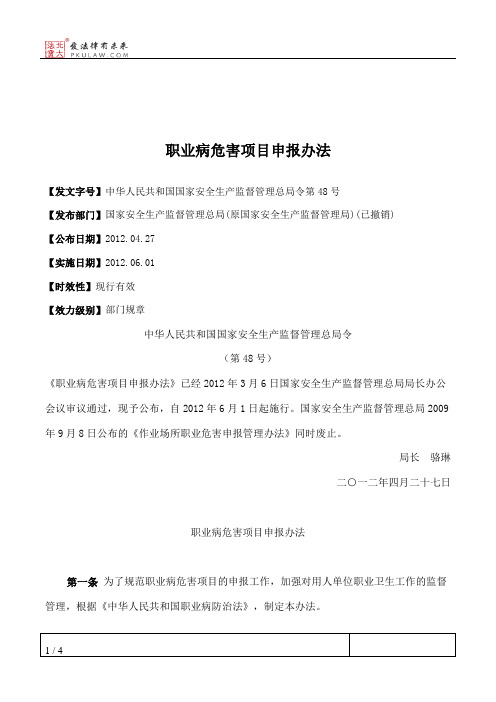
职业病危害项目申报办法【发文字号】中华人民共和国国家安全生产监督管理总局令第48号【发布部门】国家安全生产监督管理总局(原国家安全生产监督管理局)(已撤销)【公布日期】2012.04.27【实施日期】2012.06.01【时效性】现行有效【效力级别】部门规章中华人民共和国国家安全生产监督管理总局令(第48号)《职业病危害项目申报办法》已经2012年3月6日国家安全生产监督管理总局局长办公会议审议通过,现予公布,自2012年6月1日起施行。
国家安全生产监督管理总局2009年9月8日公布的《作业场所职业危害申报管理办法》同时废止。
局长骆琳二○一二年四月二十七日职业病危害项目申报办法第一条为了规范职业病危害项目的申报工作,加强对用人单位职业卫生工作的监督管理,根据《中华人民共和国职业病防治法》,制定本办法。
第二条用人单位(煤矿除外)工作场所存在职业病目录所列职业病的危害因素的,应当及时、如实向所在地安全生产监督管理部门申报危害项目,并接受安全生产监督管理部门的监督管理。
煤矿职业病危害项目申报办法另行规定。
第三条本办法所称职业病危害项目,是指存在职业病危害因素的项目。
职业病危害因素按照《职业病危害因素分类目录》确定。
第四条职业病危害项目申报工作实行属地分级管理的原则。
中央企业、省属企业及其所属用人单位的职业病危害项目,向其所在地设区的市级人民政府安全生产监督管理部门申报。
前款规定以外的其他用人单位的职业病危害项目,向其所在地县级人民政府安全生产监督管理部门申报。
第五条用人单位申报职业病危害项目时,应当提交《职业病危害项目申报表》和下列文件、资料:(一)用人单位的基本情况;(二)工作场所职业病危害因素种类、分布情况以及接触人数;(三)法律、法规和规章规定的其他文件、资料。
第六条职业病危害项目申报同时采取电子数据和纸质文本两种方式。
用人单位应当首先通过“职业病危害项目申报系统”进行电子数据申报,同时将《职业病危害项目申报表》加盖公章并由本单位主要负责人签字后,按照本办法第四条和第五条的规定,连同有关文件、资料一并上报所在地设区的市级、县级安全生产监督管理部门。
职业病危害项目申报制度

职业病危害项目申报制度一、引言随着社会经济的发展和工业化进程的加速,职业病的危害日益凸显。
为了加强对职业病防治工作的监管和管理,提高职工的工作环境与健康水平,本文旨在介绍职业病危害项目申报制度的目的、原则、程序和具体内容,以确保职业病防治工作的有效进行。
二、目的职业病危害项目申报制度的目的在于:1.规范职业病防治工作的申报程序,明确责任,加强监管;2.确保工作场所的危害因素得到有效控制,减少职工患职业病的风险;3.提高职工的安全意识和职业健康水平。
三、原则职业病危害项目申报制度遵循以下原则:1.预防为主,综合防治。
采取综合治理的方式,消除职业病危害源,减少职工的暴露风险;2.依法管理,科学决策。
依法制定和完善职业病防治相关法律法规,科学决策,确保职业病防治工作的顺利进行;3.公开透明,公正公平。
申报制度公开透明,程序公正公平,提高工作的公信力和透明度;4.分级管理,协同作业。
各级政府、企事业单位和职工应分工合作,共同推进职业病防治工作的开展。
四、程序职业病危害项目申报制度的程序包括以下几个环节:1. 项目申报企事业单位应按照职业病防治工作的要求,编制职业病危害项目申报书。
申报书应包括项目名称、工作内容、预期目标、工作方案、工作周期、工作责任等内容。
申报单位可以根据实际情况,委托专业机构进行项目申报。
2. 评审审核职业病危害项目申报书由相关部门进行评审审核。
评审要充分考虑项目的可行性、经济性和科学性,评审结果应尽快通知申报单位。
如有需要,可以进行现场考察或听取专家意见。
3. 审批批复经评审审核合格的职业病危害项目申报书,由主管部门进行审批批复。
审批部门应根据职业病防治工作的需要,及时作出批复决策,并将决策结果告知申报单位。
4. 实施监督职业病危害项目的实施应由申报单位负责,相关部门对项目实施进行监督和检查。
监督部门可以进行现场检查、数据分析、问卷调查等方式进行监督,并及时提出整改建议。
5. 结果评估职业病危害项目实施完成后,申报单位应编制项目实施报告,并及时进行效果评估。
江苏省职业病危害项目申报管理办法
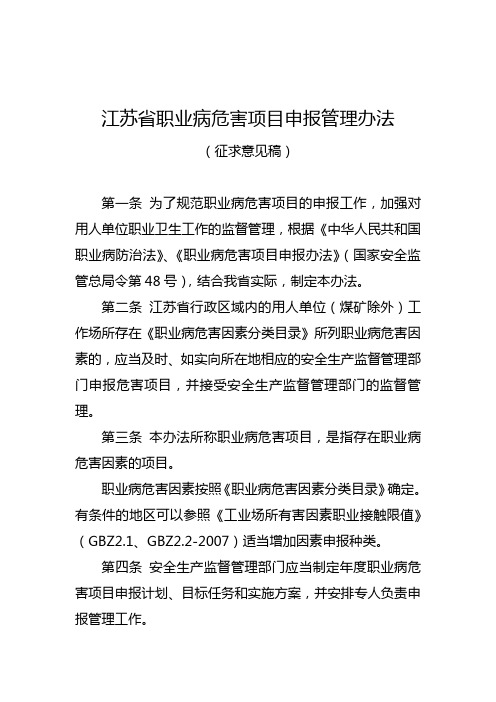
江苏省职业病危害项目申报管理办法(征求意见稿)第一条为了规范职业病危害项目的申报工作,加强对用人单位职业卫生工作的监督管理,根据《中华人民共和国职业病防治法》、《职业病危害项目申报办法》(国家安全监管总局令第48号),结合我省实际,制定本办法。
第二条江苏省行政区域内的用人单位(煤矿除外)工作场所存在《职业病危害因素分类目录》所列职业病危害因素的,应当及时、如实向所在地相应的安全生产监督管理部门申报危害项目,并接受安全生产监督管理部门的监督管理。
第三条本办法所称职业病危害项目,是指存在职业病危害因素的项目。
职业病危害因素按照《职业病危害因素分类目录》确定。
有条件的地区可以参照《工业场所有害因素职业接触限值》(GBZ2.1、GBZ2.2-2007)适当增加因素申报种类。
第四条安全生产监督管理部门应当制定年度职业病危害项目申报计划、目标任务和实施方案,并安排专人负责申报管理工作。
第五条安全生产监督管理部门应当加强对职业病危害项目申报工作的宣传培训,指导用人单位自主申报职业病危害项目。
应当将职业病危害项目申报的程序、方法和步骤等内容向用人单位进行告知。
第六条职业病危害项目申报工作实行属地分级管理的原则。
中央企业、省属企业、市级列管企业及其所属用人单位的职业病危害项目,向其所在地设区的市级人民政府安全生产监督管理部门申报。
前款规定以外的其他用人单位的职业病危害项目,向其所在地县级人民政府安全生产监督管理部门申报。
乡、镇(街道)负责安全生产监督管理的部门负责指导、督促辖区内用人单位进行职业病危害项目申报。
第七条用人单位申报职业病危害项目时,应当提交《职业病危害项目申报表》和下列文件、资料:(一)用人单位的基本情况;(二)工作场所职业病危害因素种类、浓度(强度)、分布情况以及接触人数;(三)完成职业病危害因素检测的用人单位还应当提供职业病危害因素检测报告(复印件);(四)法律、法规和规章规定的其他文件、资料。
职业病危害项目申报管理及申报工作流程

职业病危害项目申报管理及申报工作流程一、前言随着社会经济的发展和科技的进步,职业病危害日益严重。
为了保障职工的合法权益,防范职业病的发生,国家对职业病防治工作提出了更高的要求。
为此,针对职业病危害项目的申报管理和申报工作流程的规范化、标准化和科学化有着重要的意义。
二、申报管理的原则和方法1.原则(1)依法依规。
职业病危害项目的申报管理必须按照相关法律、法规和规章制度的要求来实施,确保申报程序的合法性和规范性。
(2)科学、合理。
申报管理的标准必须综合考虑各种因素,如职业病的危害程度、项目的技术可行性、资金预算等因素,做到科学、合理、可行。
(3)控制风险。
职业病危害项目的申报管理要严格按照危害等级分类规范,对于高风险、高危害的项目,需要加强申报流程的审核和管控措施,降低职业病危害的发生率和损失率。
(4)公开透明。
职业病危害项目的申报管理应该在程序上和内容上保持公开透明,保证申报评审结果的客观、公正和透明。
2.方法(1)健全管理制度。
建立职业病危害项目申报管理相关制度,做好职业病危害项目的申报、审核、备案等工作。
(2)制定评审标准。
针对不同类型的职业病危害项目,制定相应的评审标准和考核标准,参考国家标准和行业标准,确保评审结果的科学性和可靠性。
(3)加强信息化建设。
建设职业病危害项目申报及管理信息化平台,通过网络、移动端等方式开展申报流程,实现信息高效、准确、快捷地传递和交流。
(4)明确职责和权限。
申报管理中明确各个环节的职责和权限,保证工作有序进行,各方面有序协调,确保职业病危害项目的申报工作顺利推进。
三、申报工作流程1.职业病危害项目申报(1)项目鉴定:企业通过职业病项目鉴定申请,资料齐全,可以通过现场审核。
(2)项目报告:企业提交职业病危害项目报告,并附上职业病危害项目的危害等级分类表。
(3)审核备案:申报单位提交项目申报材料,经过规定程序的审批和评审,并向当地劳动行政部门或卫生行政部门备案。
2.职业病危害项目审核(1)形式审核:对申报单位的申报材料进行初审,如果资料齐全、符合要求,则进行技术审查。
- 1、下载文档前请自行甄别文档内容的完整性,平台不提供额外的编辑、内容补充、找答案等附加服务。
- 2、"仅部分预览"的文档,不可在线预览部分如存在完整性等问题,可反馈申请退款(可完整预览的文档不适用该条件!)。
- 3、如文档侵犯您的权益,请联系客服反馈,我们会尽快为您处理(人工客服工作时间:9:00-18:30)。
国家安全生产监督管理总局令
第48号
《职业病危害项目申报办法》已经2012年3月6日国家安全生产监督管理总局局长办公会议审议通过,现予公布,自2012年6月1日起施行。
国家安全生产监督管理总局2009年9月8日公布的《作业场所职业危害申报管理办法》同时废止27号令。
国家安全生产监督管理总局骆琳
二○一二年四月二十七日
职业病危害项目申报办法
第一条为了规范职业病危害项目的申报工作,加强对用人单位职业卫生工作的监督管理,根据《中华人民共和国职业病防治法》,制定本办法。
第二条用人单位(煤矿除外)工作场所存在职业病目录所列职业病的危害因素的,应当及时、如实向所在地安全生产监督管理部门申报危害项目,并接受安全生产监督管理部门的监督管理。
煤矿职业病危害项目申报办法另行规定。
第三条本办法所称职业病危害项目,是指存在职业病危害因素的项目。
职业病危害因素按照《职业病危害因素分类目录》确定。
第四条职业病危害项目申报工作实行属地分级管理的原则。
中央企业、省属企业及其所属用人单位的职业病危害项目,向其所在地设区的市级人民政府安全生产监督管理部门申报。
前款规定以外的其他用人单位的职业病危害项目,向其所在地县级人民政府安全生产监督管理部门申报。
第五条用人单位申报职业病危害项目时,应当提交《职业病危害项目申报表》和下列文件、资料:
(一)用人单位的基本情况;
(二)工作场所职业病危害因素种类、分布情况以及接触人数;
(三)法律、法规和规章规定的其他文件、资料。
第六条职业病危害项目申报同时采取电子数据和纸质文本两种方式。
用人单位应当首先通过“职业病危害项目申报系统”进行电子数据申报,同时将《职业病危害项目申报表》加盖公章并由本单位主要负责人签字后,按照本办法第四条和第五条的规定,连同有关文件、资料一并上报所在地设区的市级、县级安全生产监督管理部门。
受理申报的安全生产监督管理部门应当自收到申报文件、资料之日起5个工作日内,出具《职业病危害项目申报回执》。
第七条职业病危害项目申报不得收取任何费用。
第八条用人单位有下列情形之一的,应当按照本条规定向原申报机关申报变更职业病危害项目内容:
(一)进行新建、改建、扩建、技术改造或者技术引进建设项目的,自建设项目竣工验收之日起30日内进行申报;
(二)因技术、工艺、设备或者材料等发生变化导致原申报的职业病危害因素及其相关内容发生重大变化的,自发生变化之日起15日内进行申报;
(三)用人单位工作场所、名称、法定代表人或者主要负责人发生变化的,自发生变化之日起15日内进行申报;
(四)经过职业病危害因素检测、评价,发现原申报内容发生变化的,自收到有关检测、评价结果之日起15日内进行申报。
第九条用人单位终止生产经营活动的,应当自生产经营活动终止之日起15日内向原申报机关报告并办理注销手续。
第十条受理申报的安全生产监督管理部门应当建立职业病危害项目管理档案。
职业病危害项目管理档案应当包括辖区内存在职业病危害因素的用人单位数量、职业病危害因素种类、行业及地区分布、接触人数等内容。
第十一条安全生产监督管理部门应当依法对用人单位职业病危害项目申报情况进行抽查,并对职业病危害项目实施监督检查。
第十二条安全生产监督管理部门及其工作人员应当保守用人单位商业秘密和技术秘密。
违反有关保密义务的,应当承担相应的法律责任。
第十三条安全生产监督管理部门应当建立健全举报制度,依法受理和查处有关用人单位违反本办法行为的举报。
任何单位和个人均有权向安全生产监督管理部门举报用人单位违反本办法的行为。
第十四条用人单位未按照本办法规定及时、如实地申报职业病危害项目的,责令限期改正,给予警告,可以并处5万元以上10万元以下的罚款。
第十五条用人单位有关事项发生重大变化,未按照本办法的规定申报变更职业病危害项目内容的,责令限期改正,可以并处5千元以上3万元以下的罚款。
第十六条《职业病危害项目申报表》、《职业病危害项目申报回执》的式样由国家安全生产监督管理总局规定。
第十七条本办法自2012年6月1日起施行。
国家安全生产监督管理总局2009年9月8日公布的《作业场所职业危害申报管理办法》同时废止。
